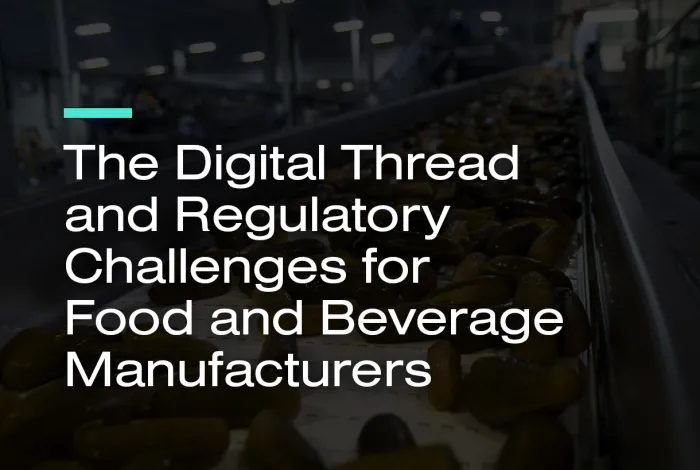

Now Available!
Get your copy of the 7th Annual State of Smart Manufacturing and hear from 300+ manufacturers in this new survey report!
Subscribe to Our Blog
For a monthly digest of expert insights, data points, and tips like the ones in this article.
The Digital Thread and Regulatory Challenges for Food and Beverage Manufacturers
Supply Chain Management, Food & Beverage
Imagine an evening newscast about a tainted food or beverage product. Recalls, bad press, and public safety concerns are the immediate nightmares of a food and beverage producer.
Once the crisis is fully underway, they may be responsible for the transportation, safe disposal, and rapid replacement of tainted goods, all of which are unplanned costs. This crisis is followed by inspections and audits from the FDA, USDA, and numerous other federal and state regulatory agencies, not to mention lost consumer trust.
This scenario has happened many times over the last few years, creating safety concerns and critical shortages while upending regular business. Food and beverage manufacturers already play a game against the clock for spoilage, quality, and other time-sensitive matters. But when this type of situation arises, the consistency of their traceability procedures is directly correlated to potential fines, shuttered production, and safety risks.
The Danger of Old School Traceability
In the past, food and beverage manufacturers had to put many administrative tasks in place to monitor the issues in their industry. Manual tracking, physical auditing, and meticulous paperwork trails certifying the chain of accountability required entire departments.
As technology became available, many of these tasks were automated. Yet, the process flow of automation followed that of production. Siloed data, lack of interoperability between software programs, and a lot of residual manual data entry and report reconciliation still left gaps and, ultimately, the possibility of disaster.
Top Regulatory Challenges for Food and Beverage Manufacturers
As recent years have shown, disruptions and unexpected challenges can pose many issues in the food and beverage industry. In response, agencies like the FDA, USDA, and others have begun changing food and beverage companies' requirements to tighten compliance. These new requirements cover many topics:
- Supply Chain Issues – Many manufacturers were caught off guard with COVID-19. The FDA allowed some product substitutions and modifications to labels for a while, but as supply chains continue to be a problem, they’re expected to develop new procedures requiring better labeling of those alternative ingredients and tighter compliance of the substitutions to FDA guidelines.
- Standards of Identity – Many FDA guidelines on identity are outdated. As innovative products hit the market in recent years, the lines have blurred on whether a product fits a standard of identity or even has a category for classification. The FDA is expected to update many identity standards to account for this.
- Redefining Healthy Labels – As new scientific evidence has come to light on what is considered ‘nutritious’, expect changes in package labeling to reflect the new guidelines. This new insight may include limiting certain common ingredients.
- Removal of Dangerous Substances – Heavy metals and other dangerous substances are under scrutiny in many product categories like baby food. What was once "allowable" in tiny concentrations may soon be mandated for removal entirely. This requirement for removal will include both food and packaging materials.
Using the Digital Thread to Navigate Regulation
It’s impossible for food and beverage manufacturers to track data manually while complying with today’s requirements. At the same time, lack of current data, interoperability, siloed data, and other issues mean that traditional software solutions aren't a good answer.
The most effective way to monitor, track, trace, and comply with food and beverage conditions and regulations is by deploying a digital thread throughout the enterprise with the Plex Smart Manufacturing Platform. A digital thread allows companies to stay on top of changing regulations by automating critical data and compliance issues in real-time to improve safety and meet new standards.
With the genuine danger of audits and recalls that could add cost or stop production, a smart manufacturing platform can quickly catch issues before they become significant problems. It can make the difference between identifying a problem with a tiny batch of ingredients and recalling an entire week's worth of product because one didn't know precisely where the issue was.
The Plex Smart Manufacturing Platform provides real-time data and insights to optimize production processes and factory monitoring. It’s a platform already widely used by the food and beverage industry to control, trace, and automate compliance.
With fully automated and documented control, everything is tracked in real time and changes to regulations and procedures to meet compliance are automatically updated across operations. As processes are optimized, manufacturers have confidence in data-driven insights to drive process improvement throughout the company while staying on top of new challenges.
See how a real-world pickles and peppers manufacturer relies on Plex for traceability and compliance in this success story.

